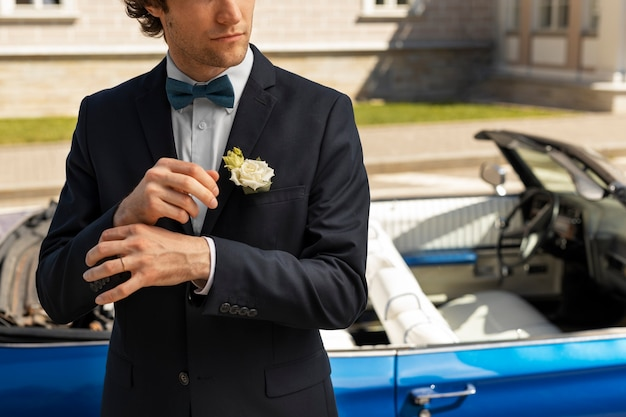
Receiving a wedding invitation often sparks a flurry of excitement—and a pinch of nervousness. One of the first things on your mind is, "What do I wear?" When the invitation requests you to dress formally, you can't help but wonder exactly what that means. Whether it’s your first black-tie optional event or a church wedding with a sophisticated vibe, understanding formal wedding attire is key to showing up as a perfectly dressed guest. It's not so much about looking fashionable—it's about respecting the occasion and feeling secure in your attire.
In this comprehensive guide, we’ll break down everything you need to know about formal wedding attire. Let's begin and make you look perfect on the wedding day.
Formal wedding attire is often described as a step above semi-formal or cocktail dress codes but just below the strict elegance of a black-tie affair. It’s a dress code that calls for sophistication, polished outfits, and a refined sense of style, while still leaving room for personal touches. The main characteristics to be noted are the following:
· Luxury Fabrics: Opt for upscale fabrics like worsted wools, mixed noble fibers (cashmere, alpaca, silk), lace, satin, organza, taffeta, or structured cotton and linen mixtures for hot climates. These fabrics elevate the look beyond casual or semi-formal options.
· Deep and Classic Colors: Darker shades like navy, charcoal grey, black, or deep shades like burgundy and hunter green would be most appropriate for formal events, although lighter hues like pale blues or earth tones can be applied depending on the venue and time of year.
· Custom Fit: Whether a suit, tuxedo, gown, or pantsuit, the fit counts. Wedding wear that's formal must be clean and crisp cut, molding to your form without feeling restricting. For a truly tailored experience, consider working with custom clothing manufacturers to ensure your attire fits perfectly.
· Elevated Accessories: The accessories make formal wedding attire stand out. In men's cases, these are ties, bow ties, cufflinks, or pocket squares; for women, think about jewelry, stilettos, and elegant clutches.
When it comes to formal wedding attire for men, the dress code offers a balance of sophistication and flexibility. You’ll typically choose between a suit and a tuxedo, with options to elevate your look through fit, fabric, and accessories. Here’s a detailed breakdown:
For a formal or black-tie optional wedding, men can opt for either a suit or a tuxedo. They're both fine, and the choice is usually one of personal taste or level of comfort with formality. A tuxedo is inherently polished and reserved for special events, making it a perfect fit for formal weddings—though steer clear of a white tuxedo, as it’s reserved for white-tie events or the couple themselves. If you choose a suit, stick primarily to darker, richer colors like black, charcoal grey, or navy, since they are seen as more elevated than their lighter-toned counterparts. Avoid extremely bright colors in order to maintain the formality and ensure your attire is consistent with the level of sophistication indicated in the dress code.
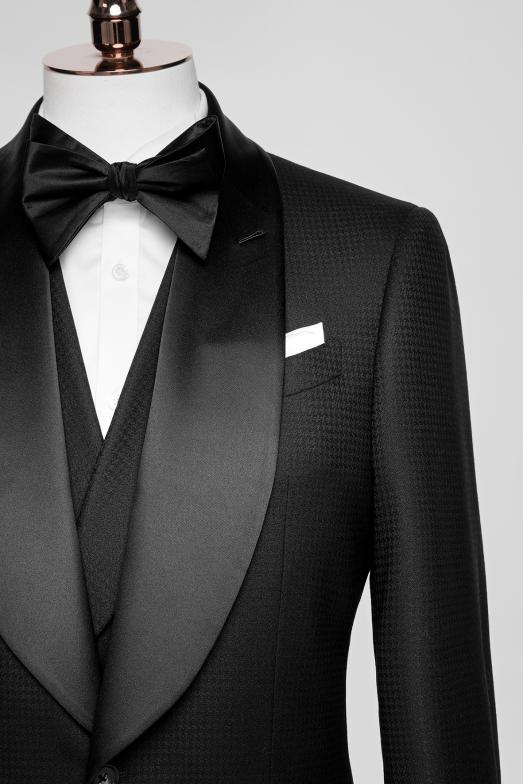
Your suit cut can offer a further kick of formality. Double-breasted and single-breasted suits are both ideal for wedding ceremonies. A double-breasted suit offers a slightly more formal, lesser-seen touch, getting the perfect equilibrium between cocktail dressing and black-tie level dress. It keeps your look distinguished from a tuxedo without compromising the dress code.
A three-piece suit—jacket, trousers, and vest—is a timeless choice that adds grace and formality to your appearance. A waistcoat under a single-breasted suit is one of the great classic styles which never goes out of fashion. Burgundy, dark blue, navy, or deep greys are excellent formal options. For a bespoke touch, explore custom formal wear to craft a three-piece suit that’s uniquely yours.
A crisp dress shirt is non-negotiable, whether paired with a suit or tuxedo. For tuxedos, a classic tuxedo shirt or French cuff dress shirt works best. With suits, opt for a white dress shirt or one in a refined color or subtle pattern. Ties are a must for formal attire weddings—both bow ties and neckties are acceptable, though bow ties are traditionally reserved for black-tie events. If you’re wearing a suit, a bow tie can bring it closer to a tuxedo-level look.
Dress shoes are essential and must be as formal as your outfit. Black, brown, or burgundy leather (avoid patent or suede) is the best. Cufflinks, a silk pocket square, or suspenders (never a belt at formal events) are the addition. As a personality touch, employ patterned socks or a colored pocket square, depending on the event.
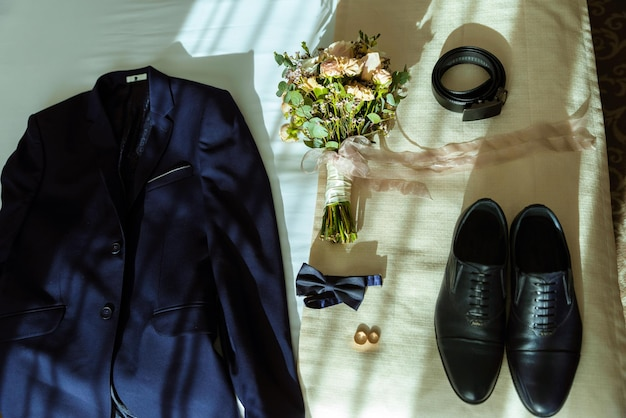
Formal attire doesn’t have to mean solid colors only. A thin windowpane or small houndstooth check can work beautifully in formal settings. Fabrics should lean luxurious—think rich worsted wools, alpaca, silk, or cashmere blends for cooler weather.
For women, wedding formal wear provides a variety of dressed-to-the-nines possibilities that marry elegance with personality. From the floor-length gowns to more contemporary options, here's what to look for:
Dresses are the standard choice for wedding formal attire, floor-length dresses being the norm. Midi dresses or elevated cocktail dresses can work if they have rich details like embroidery, lace, ruffles, or silky fabrics. Satin, lace, organza, and taffeta are good fabrics to use in order to gain a luxurious look. Avoid cotton maxi dresses—these are better suited to casual or semi-formal gatherings.
Not a dress person? A custom-designed women's pantsuit in a darker shade like burgundy or black is a stylish alternative that is just as formal. Loose or starched jumpsuits are also compliant, especially when paired with formal bling like heels and accessories. For a perfect fit, consider custom women’s clothing to tailor these modern designs to your style.
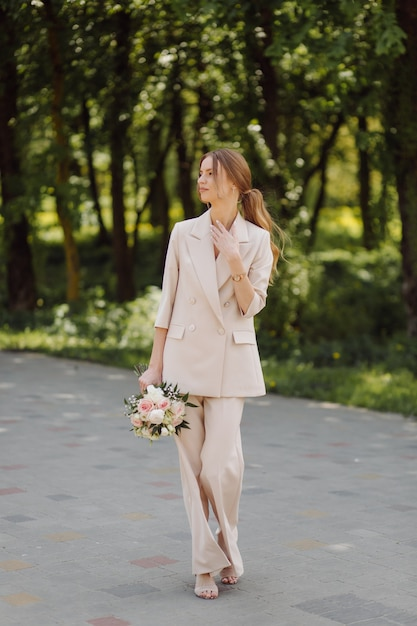
For the dramatic, red-carpet-style look, women can don a tuxedo. Classier than a pantsuit, the women's tuxedo is easily made over with accessories and has been a popular, chic choice for special events.
Footwear should be elegant—think heels, polished loafers, or fancy flats. Strappy heels or sparkly shoes add a glamorous touch, while simple gold or diamond stud earrings, necklaces, or bracelets can elevate your look. If your dress is bold, keep jewelry simple; for a simpler gown, a sparkly earring or tassel earrings can add flair.
Formal wedding attire can vary depending on the setting, time of day, or specific dress code nuances. Here's how to alter your dress code for various occasions:
Black-tie optional weddings are nearly as formalized as black-tie affairs, but with a bit of latitude. Men may wear a tux or a very dark suit (navy or black) with a tie, and women will want to dress in a floor-length gown, a very fancy cocktail dress, or a glamorous pantsuit.
For a church formal wedding, modesty is the rule. The shoulders of ladies should be covered and there should be no overly revealing or sexy attire—go for a lace short-sleeved tea-length wedding dress or floor-length wedding dress with shawl. A suit or dark-colored tuxedo is appropriate for men so long as the look is respectable and classic.
A formal beach wedding allows light-hued fabrics and a more casual hemline without sacrificing elegance. Women can dress in flowy gowns in pale or vibrant colors, silk or chiffon, and pair them with wedges, espadrilles, flats, or wide block heels to stroll on the sand. Men can choose a light-colored suit (e.g., pale blue) made of breathable fabric like linen-cotton blends, blending formal elegance with a custom smart casual twist for the relaxed setting. A light cover-up, like a pashmina, might be enough to warm you up if it gets cold.
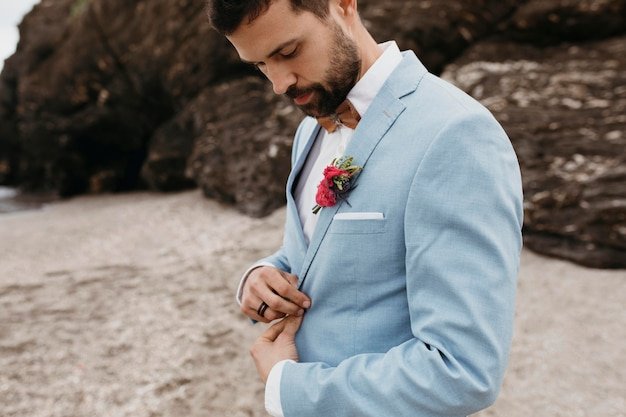
Evening formal weddings call for all-out glamour. Women can go for deep-colored gowns with sequins, ruffles, or a subtle train—think a floral sleeved gown with pockets or a lace dress with intricate details. Men should lean toward darker tuxedos or suits (black or navy) with polished accessories like a bow tie or silk pocket square.
Season may influence your color and fabric selection for formal wedding attire. This is what to wear during each season:
In warmer months, opt for lighter fabrics like pure cotton, linen-cotton blends, or silk for men, and chiffon, lace, or organza for women. However, avoid casual cotton dresses for women—this isn’t the time for them in a formal setting. A light grey linen-cotton suit for men or a pastel gown for women brings a touch of levity while remaining formal. Avoid heavier fabrics like velvet or taffeta, which can cause overheating. Colors like light blue, tan, or brighter blues work well, as do standout shades like pale purple, depending on the setting.
Cooler months call for richer fabrics and deeper tones. Men can choose pure wool blended with cashmere or alpaca for warmth and refinement, or wool-silk blends for a subtle sheen. Women can embrace velvet, satin, or taffeta gowns in earthy tones like burgundy, navy, brown, or hunter green. Long-sleeved dresses or one-shoulder gowns are appropriate, as are suede open-toe shoes or velvet pumps for a chic seasonal touch.
Accessories are the last touches that can elevate your formal wedding wear to the next level. Here's accessorizing for men and women:
Start with a classic silk tie or a bow tie (though bow ties are best reserved for black-tie attire). In winter, wool flannel ties add texture and depth; in summer, opt for a cotton or linen blend tie. Cufflinks are essential for French cuffs—go for sterling silver studs or something more novel for personality. Suspenders in tonal shades (dark brown, navy) with leather buckles are a nice touch, and never wear a belt with formal attire. Add a silk pocket square or patterned socks for a subtle flair.
Leave the casual leather purses at home—opt for a small sequined clutch or sparkly handbag instead. Shoes should be dressy, like strappy Steven Madden heels or glittery flats. A light jacket or wrap, like a pashmina, can keep you warm at evening or beach weddings. For jewelry, keep it simple with gold hoops or diamond studs if your dress is bold, or go for fun tassel earrings to spruce up a simpler gown.
It is important to know what formal wedding attire is, especially for any guest who wishes to honor the couple's wishes and feel comfortable at the event. This type of dress code requires a lot of elegance—think of it as tailored dresses, tuxedos, floor-length gowns, or stylish pantsuits—yet still leaving space for individuality. Whatever is your attraction—perhaps to a traditional navy three-piece suit, a stunning sequined dress, or a hip women's tuxedo—the trick is to make your ensemble elegant, well-fitted, and suitably occasioned.
Owing to the flexibility of formal attire, you can experiment with color, jewelry, and modern choices within the parameters of the dress code. Go for it—dress up, indulge in the elegance, and create a look that's uniquely yours for the event.
A guest at a formal wedding should wear polished, sophisticated attire that respects the dress code. For men, this means a dark suit (black, navy, or charcoal grey) or a tuxedo with a dress shirt, tie, and leather dress shoes. For women, options include a floor-length gown, an elevated midi or cocktail dress, or a tailored pantsuit, paired with heels or fancy flats and formal accessories like jewelry or a clutch.
Formal attire for a wedding refers to a dress code that’s fancier than semi-formal or cocktail attire but not as strict as black-tie. It’s often similar to black-tie optional, requiring elevated outfits like tuxedos or dark suits for men and floor-length gowns, fancy dresses, or polished pantsuits for women. It emphasizes luxurious fabrics (silk, wool, satin), deep colors, and a tailored fit, with room for personal style.
A woman can wear a short dress to a formal wedding if it’s elevated enough—think a fancy cocktail dress with luxurious details like lace, embroidery, or satin. However, floor-length gowns or midi dresses are typically the safest and most traditional choices for formal attire. Avoid casual short dresses like cotton maxis, and ensure the overall look remains sophisticated with formal shoes and accessories.
A man should wear a suit or tuxedo to a formal wedding. A dark-colored suit (black, charcoal grey, or navy) paired with a crisp dress shirt, tie (bow tie or necktie), and polished leather shoes (black or brown) is ideal. For a more elevated option, a tuxedo works perfectly, especially for black-tie optional events. Add accessories like cufflinks or a pocket square to complete the look.
Formal wear for a wedding looks polished and elegant, balancing sophistication with individuality. For men, it’s a tailored dark suit or tuxedo with a dress shirt, tie, and dress shoes, possibly enhanced with a vest or suspenders. For women, it’s a floor-length gown, a fancy midi dress, or a sleek pantsuit in rich fabrics like silk or velvet, accessorized with heels, jewelry, and a clutch. The outfit should feel refined and occasion-appropriate, avoiding casual elements.